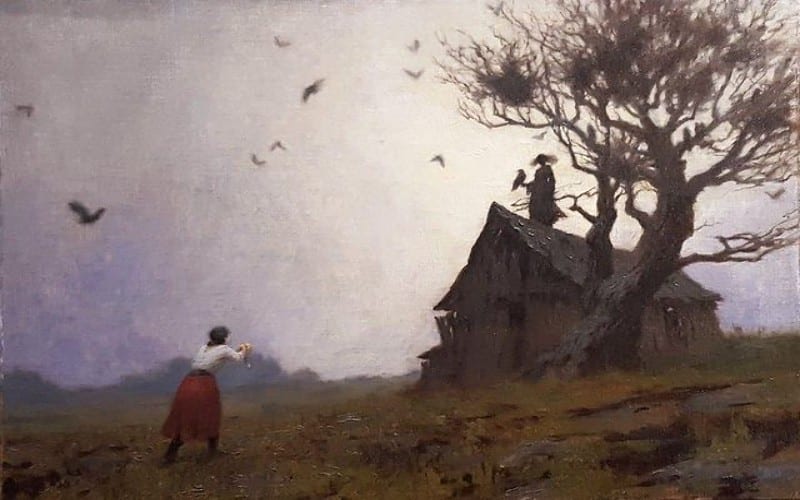Death, although unpleasant and feared by many, is a crucial part of life. It makes no wonder that deities representing death were highly revered among many cultures. After all, death makes way for a new life, and it is the ultimate comfort from pain and suffering. Such is the case with the Irish/Celtic goddess Morrigan.
She is a powerful, omniscient goddess that can bring imminent doom to their enemies, but she is also a powerful ally if you know how to appease her. Additionally, Morrigan is an all-seeing prophet that can predict the outcome of battles.
Death, war, and destruction are all terrifying concepts, but sometimes, they are necessary to purge the world of evil and injustice. Morrigan is their embodiment, and as such, she was a vital part of early Irish history.
The Morrigan History and Origins
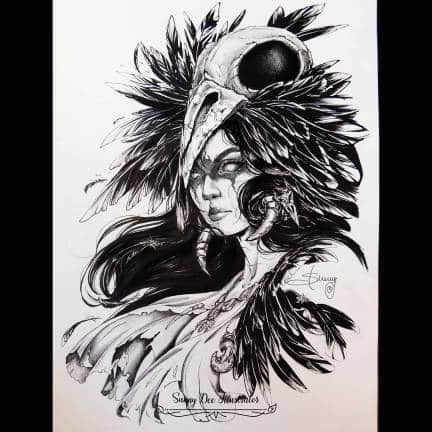
The first mentions of Morrigan are in 9th-century Latin manuscripts. As an individual, she was first depicted in the Ulster Cycle, a collection of medieval Irish heroic legends written in the period between the 7th and 15th centuries.
Morrigan also appeared in the Mythological Cycle, Lebor Gabála Érenn, Cath Maige Tuired, and other works of Irish mythology. Her name has interesting origins, too, as it originates from Old Irish words for “terror” and “greatness.”
According to the legend, Morrigan is the daughter of Ernmas, another powerful Irish goddess that was often called “mother goddess.” The father remained unknown, but it was certainly one of the mighty Irish gods. Morrigan is married to Dagda, a god of fertility, agriculture, strength, magic, and weather.
Three Goddesses
However, Morrigan wasn’t just one goddess. She is actually a trinity goddess, meaning she can appear as an individual goddess or as three different sister goddesses. In her tripartite form, Morrigan is named Ériu, Banba, and Fódlad.
Ériu
A matron goddess of Ireland, Ériu is often considered the personification of the whole country. She is the goddess of fertility, agriculture, and abundance.
Banba
Similar to Ériu, Banba was the goddess of earth, land, and fertility. However, she was also the goddess of war, which is a clear connection to Morrigan.
Fódla
Fódla is the third sister that was Morrigan. When the Milesians (the modern Irish people) arrived in Ireland, one of them was the famous bard Amergin Glúingel.
As he was preparing to name the country that had no name until then, each one of the goddess sisters asked him to name it after her. Eventually, Amergin decided to name Ireland after Ériu, but Fódla remained an alternative name.
Fódla was also a Queen to king Mac Cecht. Mac Cecht was no ordinary man either, as he was the grandson of Dagda. This may sound confusing as Dagda was the husband of Morrigan, and Fódla was one of her personifications, but such situations are quite common among gods.
According to another version, the trinity of sisters that were Morrigan were actually the goddesses Badb, Nemain, and Macha. Badb was the goddess of faith, Nemain was the goddess of havoc, and Macha was the goddess of fear.
No matter which version is “correct,” this is a prime example of how complex Morrigan is. She can be many different things simultaneously; she can be nurturing or destructive, an ally or nemesis.
This also symbolizes that each person has not one, not three, but numerous sides of their personality, with various life circumstances determining which side will show itself at the moment.
Two Battles of Moytura (Cath Maige Tuired)
Tuatha Dé, a tribe of gods to which Morrigan belonged, was at war with Fomorions, another supernatural race of monstrous beings. During their first battle, Morrigan used powerful spells to help Tuatha Dé win.
However, the second battle wasn’t as easy for Tuatha Dé. As the gods prepared for this battle, Dagda searched for his wife, Morrigan, to ask about her prediction for the battle outcome. The two had intercourse, and after they were done, Morrigan prophesized victory for Tuatha Dé, but with a great bloodbath.
When the battle arrived, the gods asked Morrigan which of her skills she brought to the battlefield. Morrigan answered with, “What I shall follow, I shall hunt.” Soon enough, the battle turned into a bloodbath, as Morrigan predicted.
The battle finally ended when Morrigan, with her cries, incited the bloodlust among gods that finally managed to defeat Fomorions, pushing them into the sea.
Morrigan and Cú Chulainn
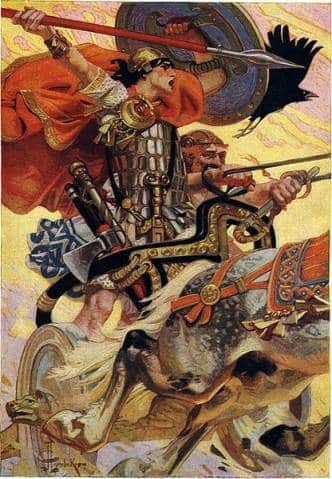
Only a few gods and humans proved worthy opponents to the Morrigan goddess. However, a mighty demigod warrior Cú Chulainn was something different. Cú Chulainn’s first victory over Morrigan was probably when she fell in love with him.
Little is known about how they first met, but the goddess quickly fell in love with the hero. Since she could transform into anything, she transformed into a beautiful maiden and tried to seduce Cú Chulainn.
Despite her otherworldly beauty, Cú Chulainn declined Morrigan’s advances, and that’s when things got heated. It seems that the phrase “Hell hath no fury like a woman scorned” is older than time.
Eel
Using her transformation powers, Morrigan transformed into an eel and swam to Cú Chulainn as he crossed a fjord. Morrigan tripped Cú Chulainn, to which he responded by kicking and hurting her.
Wolf
Morrigan quickly recovered and decided to transform into a wolf. She tried to chase a big herd of cattle and drive it directly to Cú Chulainn. However, Cú Chulainn was also quick, and he used his slingshot to fire a stone straight into Morrigan’s eyes, leaving her temporarily blind in one eye.
Cow
Still, Morrigan wasn’t a quitter, and she decided to transform into a cow this time and try to lead the herd stampede over Cú Chulainn. Cú Chulainn managed to avoid the herd, and he used his slingshot on Morrigan one more time.
This time, he managed to strike one of her legs, breaking it and forcing Morrigan to accept the defeat. At least, he thought so…
Old Woman
Tired from this weird fight, Cú Chulainn was walking to his base. Somewhere along the way, he met an old lady sitting on a little stool and milking a cow. He started a conversation with this old lady, failing to notice two details: her blind eye and a broken leg.
Yes, you guessed it right: that was Morrigan. It seems that quitting wasn’t on her agenda that day, and she wasn’t leaving Cú Chulainn alone until she emerged victorious.
She offered him a drink of fresh milk. Exhausted from the fighting, Cú Chulainn suspected nothing and gladly accepted to drink the milk. After finishing the drink, Cú Chulainn thanked and blessed the old lady.
Little did he know that his blessing healed Morrigan from her injuries and restored her to full power. However, even though she had a chance to defeat the now-tired Cú Chulainn, Morrigan decided to leave him alone. After all, she was victorious by outsmarting him!
Final Goodbye
This interesting duo met once again right before Cú Chulainn’s death. As he was en route to his next battle, he encountered a woman washing bloodied armor (another symbol of Morrigan). This was a bad omen that symbolizes death, but Cú Chulainn ignored his gut feeling and went on to face his enemy.
As you probably guessed, Cú Chulainn was mortally wounded in the battle. With the final atoms of his strength, he managed to find and use twine to tie himself upright to a nearby boulder. This allowed him to stand and frighten his enemies even while dying.
While he was standing and taking his last breaths, a crow landed on his shoulder. That was Morrigan, visiting him one more time. Many interpret this as her final victory over him, but I like to look at it from a different perspective.
As a mighty warrior that could defeat anyone, Morrigan finally found her equal in Cú Chulainn. She was entertained by this, and she probably respected Cú Chulainn for his fighting skills.
After all, if she wanted to enjoy his demise, she could’ve killed him during their first encounter, but she let him go instead. Her presence at the time of his death was not jubilation of his demise. She was paying him a tribute and accompanied him in his final moments.
The Morrigan And The Moon
As a tripartite goddess, Morrigan also represents the moon and its three phases: new, waxing, and old. As such, she is the goddess of death, but she is also the goddess of life and transformation.
Just like the moon need to almost disappear to reach its full glory only a few days later, Morrigan needs to bring death and destruction to set the path for rebirth and a new life.
The Morrigan And Hecate
Just like with many other deities, their archetypes surpass any man-made borders. It is common for completely different cultures to have similar or almost the same gods and goddesses.
Morrigan and the Greek goddess Hecate are good examples of this, as there are many similarities between them. Both goddesses represent the dark, primordial feminine energy that can be quite powerful and even destructive.
Both goddesses were connected to death and dying. Just like Morrigan, Hecate is also symbolized by the three phases of the moon, and she represents maiden, mother, and crone.
However, despite their similarities, there are also many differences between them. For example, Hecate is the goddess of magic and witchcraft, while Morrigan is the goddess of war, and as such, they have completely different personalities and powers.
Morrigan and Morgana
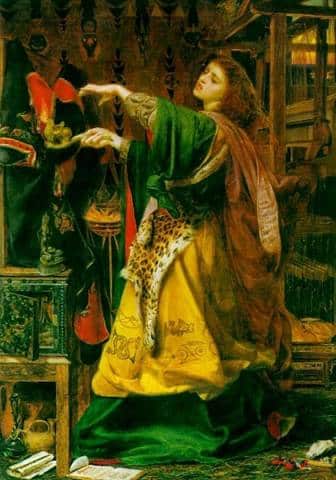
Morgana Le Fay, Lady of the Lake, and Lady of Avalon were only some of the identities of the famous character from the King Arthur legends. Usually described as a seductress that used magic to start a chain of bloody events, Morgana was at least partially inspired by Morrigan.
Still, their similarities end there. Even their names, although similarly sounding, have completely different origins and aren’t related at all.
Morrigan and Banshees
Banshees were female spirits from Irish folklore that announced death through disturbing shrieks, wails, screams, and keens. They were often depicted as pale women with bloodied eyes and long, red hairs.
However, Banshees could also transform into old ladies or into young maidens. A banshee would often take the appearance of a young girl from a certain family to alert other family members that they would die soon.
Morrigan was also known as the messenger of death that could change her appearance on a whim. That is why she is considered to be a forerunner to banshees, as she was a part of Irish folklore for a much longer time.
Legacy
Morrigan was the goddess of death and war, but she teaches us so many important lessons. For example, she is a good example of female power and that we don’t have to be weak just because we are female.
Even though she is considered a goddess of death, it remains ambiguous whether she is the bringer or simply the messenger of death. In either case, Morrigan teaches us that we need to let some parts of our lives “die” for others to flourish.
Her transformative powers teach us that, in order to achieve our goals, we need to be ready for changes. Sometimes, we must change our surroundings, place of living, habits, and even our friends to achieve our full potential. Oftentimes, we need to change ourselves first in order to notice changes around us.
Finally, Morrigan teaches us that everyone is a complex person with many different sides to them. As much as we like to think that we are the same person no matter in whose company we find ourselves, that is incorrect.
If different people from our lives had to describe us, they would all describe different persons. For some, we are caring and gentle; for others, we might be funny and careless, and there are people who would see us as insecure and too serious.
We are complex and multidimensional beings that possess many character qualities. Which of these qualities will show depends on our mood, the situation, and the people around us.
Regardless, no matter how we present ourselves and no matter how many personalities and identities we assume, we still remain the same person.
Goddess Jewelry
There are many reasons why you might want to keep a healing crystal or stone close to you. Getting closer to your goddess by wearing her color or crystal is a great one. That they also look great as jewelry only makes it so much better!
Here is a guide to crystal jewelry you hopefully will find helpful. In it is a list of 30+ crystals and links to some really great looking jewelry with that crystal or stone. Enjoy!
Frequently Asked Questions
Bloodstones, rubies, and obsidian are often associated with the Morrigan.
If Morrigan decides to call you, she will do it through various disturbances in your everyday life. But don’t worry; once you respond to her call, she will help you unlock your full potential and awaken the fierce warrior that you are. You should visit a trusted psychic or medium to help you recognize Morrigan call.
Most of the time, Morrigan is associated with ravens, crows, and wolves, as she often transforms into these animals. There are no mentions of her transforming into a spider, but knowing her powers, it isn’t impossible.
No, as it was already pointed out, the two goddesses share some similarities, but they are different and certainly not the same.
No, Morrigan is not a Norse goddess; she is an Irish/Celtic goddess.
Some of the plants that Morrigan likes are mullein, red clover, ginger, vervain, and thyme.
The Morrigan Goddess Symbol
Since Morrigan is the goddess of war and death that likes to transform into crows and various other animals, it is natural that she is symbolized by those animals and by other things that are often associated with death, war, and destruction.
General
As the goddess of death in the battle, Morrigan could often be seen circling around the battlefield as a crow or raven. This is why crow or raven skulls are the most common symbols of Morrigan, as well as their feathers.
Morrigan’s other symbols include candles, swords, axes, spears, shields, and the moon.
Animals
As mentioned in the previous section, Morrigan often transformed into crows and ravens, and that is why crows, ravens, and other scavenger birds are Morrigans’ most common animal symbols.
Other animals that represent Morrigan are wolves, cows, and horses.
Plants
Belladonna and other nightshade plants are often used as symbols of Morrigan as they can be poisonous and deadly, just like Morrigan.
Other plants associated with the Morrigan are ginger, vervain, mullein, red clover, thyme, blackthorn, juniper berries, dragon’s blood, mugwort, and yew.
Perfumes/Scents
Scents that symbolize Morrigan are moss, musk, and milk. These scents symbolize earth, death, and birth, concepts that are closely related to Morrigan.
Gems and Metals
Since she is the goddess of death and war, there is certainly a lot of blood surrounding her. That’s why she is often represented by bloodstones, garnets, and rubies.
Other crystals for the Morrigan are amethyst, obsidian, jet, and clear quartz.
Colors
Red is certainly the color that suits Morrigan the most. Red is the color of blood, and there is a lot of blood where Morrigan can be found – on the battlefield. Other colors that symbolize Morrigan are black, white, purple, and dark blue.
Embracing the Call of Morrigan: Recognizing Her Presence and Cultivating a Sacred Connection
Have you ever felt an inexplicable fascination with crows, ravens, or the battlefield and wondered if it’s more than just coincidence? For many spiritual seekers, the goddess Morrigan may be extending an invitation to connect. Discover how to recognize the signs of her calling, invoke her presence, and cultivate a meaningful relationship with this powerful Celtic goddess.
How to know if Morrigan is calling you
Morrigan often communicates through nature. Encounters with crows, ravens, or feelings of empowerment in intense situations might be signs. Be aware of any animals that seem drawn to you, as Morrigan frequently reaches out through her associated creatures.
Dreams and visions are another way Morrigan may connect. Dreams featuring her or her symbols, like the crow or raven, can be significant. Similarly, visions of dark, mysterious energy might signal her presence.
Lastly, pay attention to synchronicities in your life. Repeated encounters with her symbols, or a strong attraction to her stories and mythology, can indicate that Morrigan is calling you. These patterns may seem coincidental, but they’re worth noting.
Invoking Morrigan
To call upon Morrigan, choose a location with a sense of mystery or power. Incorporate her symbols, such as the crow, raven, or images of her into your chosen area. This will help establish a connection with the goddess.
During your ritual, light candles, particularly black or dark red, representing her warrior energy. Offer symbols of Morrigan, such as feathers, tokens, or even written intentions. These offerings demonstrate your dedication and respect for her.
In meditation, focus on your breath and clear your mind. Visualize Morrigan, her symbols, and the energy she embodies. Quietly ask for her guidance, and be open to any insights that may arise during your meditation.
Signs that Morrigan is present
Recognizing when Morrigan is with you is essential to deepening your connection with her. The goddess often manifests her presence in various ways, from emotional sensations to visual cues. Here are six signs to help you identify when Morrigan is near:
- Emotional sensations: Feelings of courage, strength, or empowerment can indicate her presence.
- Physical reactions: Sudden chills, tingling sensations, or goosebumps may signal she’s near.
- Visual cues: Flashes of dark energy, shadows moving, or glimpses of her symbols can be signs.
- Auditory cues: Hearing whispers, cawing of crows or ravens, or intense wind may suggest her presence.
- Nature occurrences: Unusual encounters with crows or ravens can be a signal.
- Intuitive connection: A strong sense that Morrigan is with you, even if you can’t pinpoint why, can be a sign of her presence.
Cultivating a relationship with Morrigan
To build a deeper connection with Morrigan, establish a consistent practice of meditation, prayer, or ritual to honor her. Make regular offerings, such as during the dark moon, to demonstrate your commitment to the goddess.
Embrace her values by cultivating inner strength, resilience, and courage in your life. Seek transformation and personal growth, as these aspects are central to her being. Aligning your life with her principles will help deepen your connection to her.
Lastly, study her mythology and history. Read about Morrigan and her place in Celtic mythology, and engage with others who share your interest. By exchanging insights and experiences, you’ll develop a richer understanding of the goddess and strengthen your bond with her.
Meditations For Connecting With The Morrigan
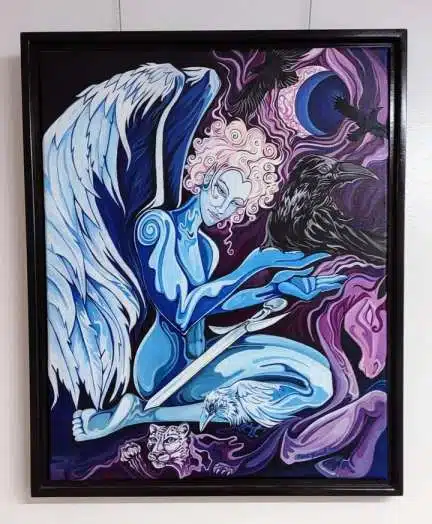
- Morrigan, the goddess of death, help me accept the loss of my loved ones and give me the strength to continue with my life.
- Help me accept the transcience of life and help me look at death as a part of life rather than as the end of it.
- Morrigan, the goddess of transformation, help me transform into the best version of myself!
- Give me the strength and the perseverance to never give up on my goals.
- Don’t let me accept the defeat too easily; instead, help me emerge victorious from all my life battles.
- Morrigan, give me the wisdom to let the bad relationships and old dreams die so that I can enjoy better relationships and achievable dreams!
- Help me explore and embrace the different aspects of my personality and teach me how to nurture the best parts of me.
- Give me the strength to crush my enemies and make them kneel in front of my power.
- Morrigan, help me to accept when things come to an end.
- Allow me to move on and devote my energy to new and exciting conquests.
Want To Bring More Morrigan Qualities Into Your Life?
- Are you stuck in a dead-end job or in a relationship that makes you unhappy? Gather the strength to cut the strings that hold you back and spread your wings to reach a new chapter of your life.
- Don’t let yourself stagnate. Always work on yourself and become a better version of yourself with each day. Exercise, learn a new skill, travel abroad, meet new people, and change your appearance. Life is too short to live it as a routine.
- Make a list of your dreams and ambitions. Select the achievable goals. Analyze each one of those goals and lay out the steps to reach them. Work towards achieving those goals, one step at a time. Each goal achieved will be a battle won.
- Show mercy even to your enemies and rivals. Don’t stoop to low punches, and show some grace instead. Avoid saying things in the middle of the fight that you will regret later.
How To Thank the Morrigan and Appease Her?
You can offer her mead, milk, whiskey, apples, water, fish, and meat. You can feed crows, ravens, and other birds in your area. Finally, you can always find a way to transform into a better version of yourself. Morrigan will certainly appreciate your efforts!
Other Goddesses
If you enjoyed this post we are sure you will enjoy getting to know some of the other goddesses we also write about. You can find the complete list of goddesses sorted across regions and religions here.
Featured Image Credit: lauralh81

